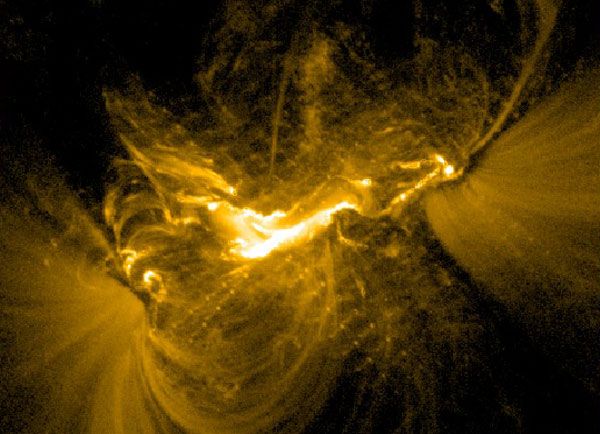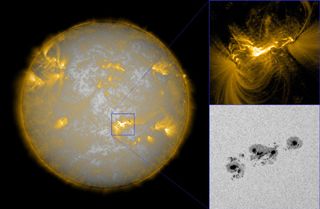What the Heck Is This?

That is not the inside of a light bulb, nor anything else created by humans.
Astronomy buffs stand a pretty good chance of guessing this one, I bet.
It's a major solar flarethat erupted in February, and which was recently explained in a new study. The bright release of light was part of an X-class flare — the strongest type, and in this case the strongest one in almost five years — spawned by rotating sunspots. See the full image below.
Sunspots are cool regions on the sun where magnetic activity is extreme and twisted. Rotating sunspots, the new study found, can spur a flare. "Twisting the sun's magnetic field is like twisting an elastic band," Daniel Brown at University of Central Lancashire in England. "At first you store energy in the elastic, but if you twist too much the elastic band snaps, releasing the stored energy."
The electromagnetic radiation from a solar flare — radio waves, visible light, X-rays and more — reach earth in about 8.3 minutes, covering (by definition) a distance of 8.3 light-minutes.
Got a strange or interesting photo related to science, nature or technology? What the Heck, send it to me, and maybe I'll use it. And you follow me on Twitter or Facebook.

Sign up for the Live Science daily newsletter now
Get the world’s most fascinating discoveries delivered straight to your inbox.
Robert is an independent health and science journalist and writer based in Phoenix, Arizona. He is a former editor-in-chief of Live Science with over 20 years of experience as a reporter and editor. He has worked on websites such as Space.com and Tom's Guide, and is a contributor on Medium, covering how we age and how to optimize the mind and body through time. He has a journalism degree from Humboldt State University in California.











